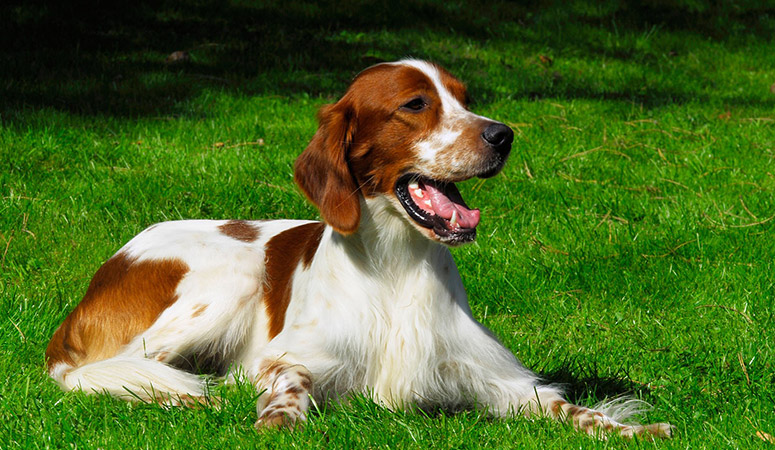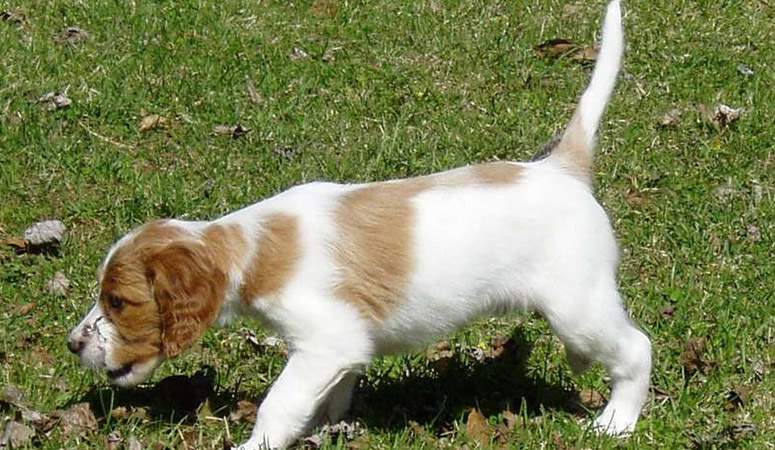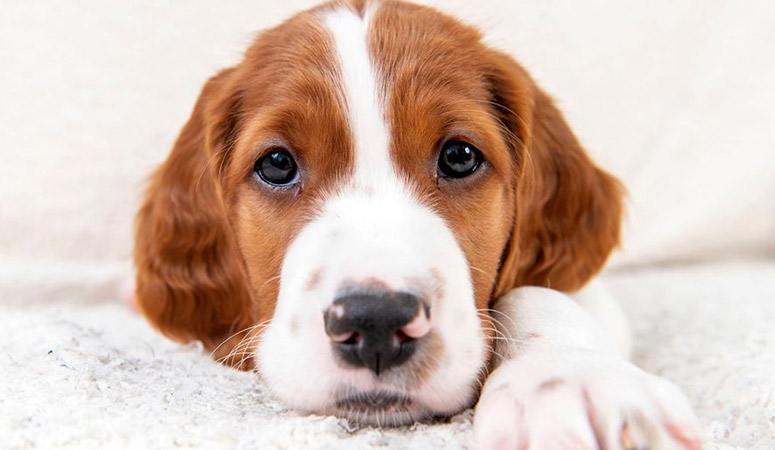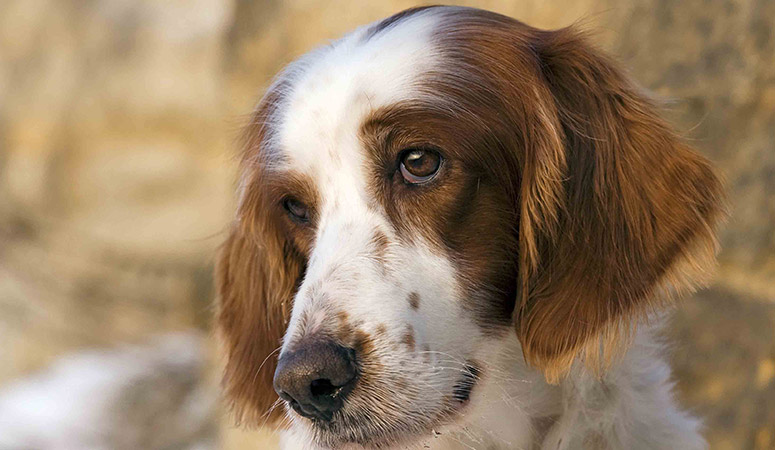Irish Red and White Setter
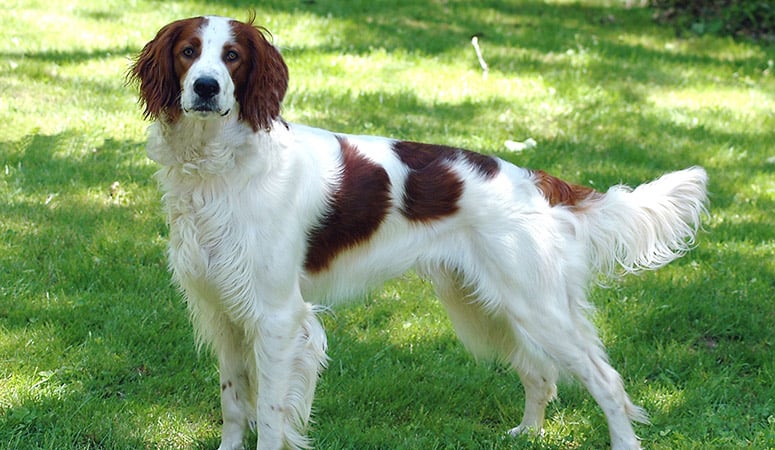
Originally bred as ace hunting dogs, the Irish Red and White Setter is athletic with substantial build, which enables this breed to hunt with speed and stamina, and today they are still popular sporting dogs. They have enough stamina and bird sense to get the job done any day of the week and twice on Sunday. Their infectious joyfulness and friendly temperament make them excellent family dogs.
| Other Names | IRWS, Irish Setter, Irish Red Setter |
| Color | Red and White |
| Height | Males: 23-27 inches. Females: 21-25 inches. |
| Weight | Males: 70-75 pounds. Females: 50-65 pounds. |
| Life Span | 11-15 years |
| Personality | Courageous, Spirited, Determined |
| Exercise | Needs Lots of Activity |
| Origin |
| Popularity | #155 |
| Groom Needs | Weekly Brushing |
| Kids Friendly | Yes |
| Dog Friendly | Yes |
| Watch Dog | |
| Family Dog | Yes |
| Litter Size | 6-12 puppies |
Irish Red and White Setter Pictures
Irish Red and White Setter Video
Introduction
The Irish Red and White Setter is built heavier than its solid red cousin, the Irish Setter. They also have a broader head with a reduced peak at the back of it. Irish Red and White Setters (IRWS) are keen fun lovers and when they come of age, space is required to run around as these dogs are highly athletic. They come in short and flat body coats with long silky feathering or fringes around the neck, chest, under the belly, behind the front legs, the back legs and around the ears. The major difference between them and the Irish Setter is their red and white coat color. They appear strong and powerful, with elegance and balance.
A standard male stands 24-26 inches at the shoulder and weighs somewhere around 40-60 pounds. A similar female measures around 22-24 inches and weighs between 35 and 50 pounds. Classified as members of the Sporting Group by the AKC, Irish Red and White Setters have an average life expectancy of 10-15 years.
Living with Irish Red and White Setter
Grooming the Irish Red and White Setter is a fairly simple job. An all-over grooming once a week with a soft brush and a slicker or comb to eliminate any tangles will keep the dog looking his best.
The Irish Setter’s glossy coat needs daily brushing and combing the coa to keep it healthy and free from matting. With frequent brushing, they need a bath only every month or two. A bath every month or so is usually sufficient.
It is important that the breed look as natural as possible, although scissors or clippers might be used to tidy up the rough edges just for the sake of neatness.
Nails should be trimmed every few weeks, as needed to prevent cracking. Brush the teeth frequently with a vet-approved pet toothpaste for good overall health and fresh breath.
The Irish Setter’s pendant ears should be checked weekly for signs of infection, including redness and an unpleasant odor. Wash their ears gently with a dog-friendly cleanser to prevent dirt build-up that can cause infections.
The Irish needs exercise, and lots of it. It is not fair to take a dog selected for boundless energy and expect it to sit inside. A minimum of one hour of hard strenuous games and exertion a day is recommended. Several play sessions, agility training, or hunting will meet their exercise requirements.
With high energy, the Irish Setter is not suited as an apartment dog. A bored and under-exercised IRWS can be a handful to live with. Provide the IRWS puppy with plenty of low-impact activity to channel his abundant energy and stimulate his mind.
Regular exercise and long walks while this breed is in its growth stage (puppy to 18 months) is important to protecting their forming joints. Upon maturity, the Irish Red and White Setter is an ideal walking, hiking, and biking companion.
They benefit from having a large yard where they can run around and play, though they shouldn’t be left alone outside for long. They are inquisitive and will try to find a way out to explore. Beyond the yard, they should be taken for long walks, hikes, runs, or days in the field.
Generally, the Irish Red and White Setter requires good quality dry dog food, given over the course of two feedings. But the amount will vary, however, based upon your Irish Setter’s activity level and age.
The quality of dog food you buy also makes a difference — the better the dog food, the further it will go toward nourishing your dog and the less of it you’ll need to shake into your dog’s bowl. Talk to your veterinarian about the optimal diet and quantity of food for your Irish Setter.
There is no one particular diet that is best for your Irish Red and White Setter. You should always feed your dog the best quality food you can, one with quality ingredients and fewer byproducts. Complete dog foods will have all the vitamins and minerals needed for both puppies and adults.
Some Irish Setters are prone to getting overweight, so watch your dog’s calorie consumption and weight level. Treats can be an important aid in training, but giving too many can cause obesity.
Clean, fresh water should be available at all times.
Learn about which human foods are safe for dogs, and which are not. Check with your vet if you have any concerns about your dog’s weight or diet.
Irish Red and White Setters are generally healthy dogs, but they also have health conditions that can be a concern, especially if you don’t screen the breeder carefully. They include hip dysplasia, eye problems such as cataracts and progressive retinal atrophy, hypothyroidism, and an immune disorder called Canine Leukocyte Adhesion Deficiency (CLAD), panosteitis, epilepsy and gastric torsion.
Not all Irish Setters will get any or all of these diseases, but it’s important to be aware of them if you’re considering this breed.
As with all breeds, the Irish Setters’ ears should be checked regularly for signs of infection, and the teeth should be brushed often, ideally every day, using a toothpaste formulated for dogs.
There are several health tests considerations specific to the breed, such as ophthalmologist evaluation and hip evaluation. The breed’s gene pool is not large, so canine Leukocyte Adhesion Deficiency DNA test is especially important.
Responsible breeders test all breeding stock for conditions that can affect the breed. Regular visits to the vet for checkups and parasite control help to ensure the dog a long, healthy life.
Total Annual Cost: $3239
Cost is estimated for the first year and may vary depending on many factors, such as dog food, health care, leash, collar, licensing, possible fencing, crates, training and obedience classes, dog-walking, grooming, treats, toys, flea, tick, and heart-worm meds, microchips, etc.
Irish Setters were bred as hunting dogs and excel at field training. The breed’s high spirits can make them a challenge to train. Irish Setters are eager students who will learn the beginner and advanced training quickly, especially when the lessons are changed up frequently and fun, because they can get bored easily.
Early socialization and puppy training classes are recommended. His intelligence, energy, and devotion to his human make him a natural at obedience, hunting, tracking, and agility.
Agility training and dog sports are good outlets for the smart and rambunctious Irish Setter. They love the opportunity to show off their skills and relish spending time outdoors with their people.
Since young dogs are full of boundless energy and easily distracted, you may have your work cut out for you. A key is to keep training sessions short, interesting, and upbeat, and as long as you start at an early age. It may be helpful if you isolate your Irish Red and White Setter from other dogs and potential distractions while training them.
The IRWS is very eager to please and reacts well to a positive training approach involving lots of praise. They will not respond well to negative training or loud or raised voices. In fact, it may become timid or will avoid people when this training method is employed.
History
Setters had probably existed since the ancient Roman Empire, although they are affiliated with British origins. Long ago, setters were bred to indicate the location of game birds during a hunt, hence they were classified in the United Kingdom as gun-dogs. The common quarry included pheasants, grouse, partridge, woodcock and a host of others. The hunter hid away at close range to observe the dog. On the dog’s signaling of bird presence, the hunter would hurriedly pitch a hawk in the air to dispatch the alerted bird. With technological advancement and time, hawks were later replaced by nets, then by guns, while the setter adjusted to the demands of each method.
The popular setters in Ireland were of the solid red color which was often interbred with the red-and-white-colored varieties before the 1700s. They were regarded as varieties of the Irish Setter breed. Time passed and the culture of interbreeding the different colored varieties ceased. Each variety was bred with its color kind, although the red-colored variety soon became even more popular at dog shows and amongst breed fanciers. Then, the red and white variety began to plummet into extinction. Only a few breeders of the 1800s and even fewer of the 19th century bred the red and white setter type. Notable amongst such breeders of that era was the Rossmore family, who preserved red and white setters till the 20th century.
The red and white variety of the Irish Setters were soon recognized as a distinct breed in order to facilitate the revival of the breed which was on the brink of extinction. Many individuals of the latter part of the 20th century, played major roles in the resuscitation of the Irish Red and White Setter to what we know today. The breed gained an AKC recognition in 2009.
Helpful Information
Breed Club: IRISH RED AND WHITE SETTER ASSOCIATION OF AMERICA
Breed Club Link: https://www.irishredwhitesetterassociation.com/
Breed Club Rescue: Irish Red and White Setter Association of America Rescue
Breed Club Rescue Link: https://www.irishredwhitesetterassociation.com/rescue.htm

